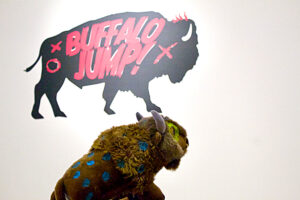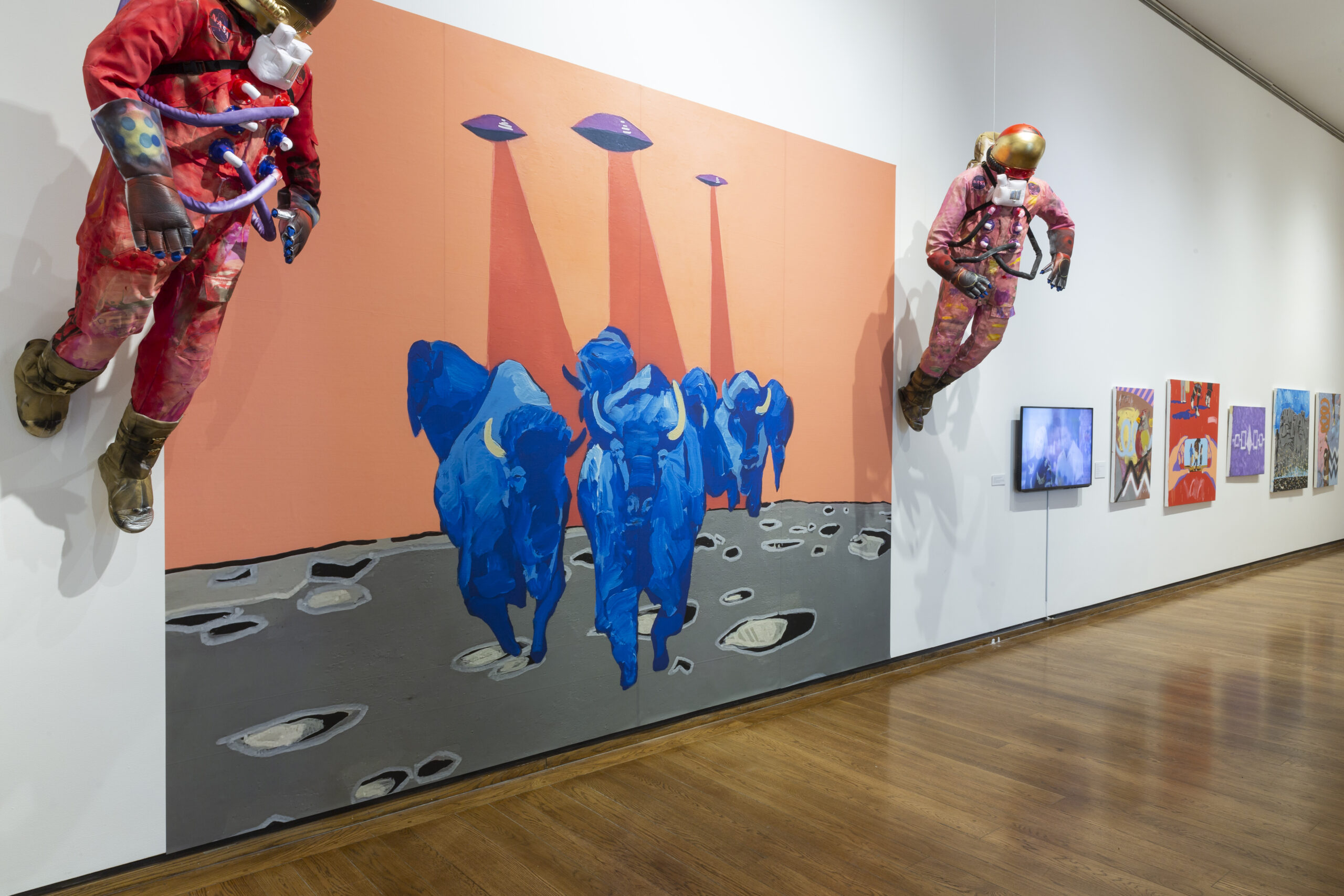By Madison Neuner

“Buffalo Jump” is an interactive piece that includes remote-controlled stuffed buffaloes that museum visitors can guide over a wooden ramp. Hyde based this piece on a Native hunting practice of driving many bison over a cliff at one time. Photo by Madison Neuner.
It was a long time between the start of Frank Buffalo Hyde’s career and his use of the buffalo in his artwork.
“I resisted using any sort of buffalo imagery because my middle name was Buffalo,” he said. Hyde said many people thought that he’d made up the name to match his artwork, which centers on Native American culture.
But he couldn’t find a better name.
His grandparents, Frank Henry and Mary Buffalo, are his namesakes. His name became a source of power for him. “If you don’t remember my work, you remember my name,” he said.
Hyde came back to his hometown in June to open the exhibition, Native Americana, at the Everson Museum of Art. While one of its paintings, “American Idol,” was in the Everson’s 2022 group show, Forever is Composed of Nows, this is the first time Hyde’s had the galleries to himself. The mixed media exhibit blends significant Native symbols with broader cultural iconography that many people recognize like logos, astronauts, and hamburgers.
“It’s an easy way to let people in,” Hyde said. “You see the American Idol and you’ll get fires in your neural net about hearing the theme music, or sitting there with your family, or singing in your room saying, ‘I could be on there.’”
Make People Uncomfortable
Though the familiarity of these icons in his work may be comforting, Hyde’s goal is to make people uncomfortable. “Still today a lot of the most successful Indigenous artists are very non-threatening,” he said. “They’re the Native artists that curators and collectors can handle.”
Hyde aims to break that cycle. “I’ve been lobbying for contemporary Native art to be included in all of these spaces that traditionally were held for non-Native artists.”
He sees his art as reciprocal—it affects the audience, and the audience affects it. If he has a piece in an exhibition and it returns to him in Minnesota, he sees it as an “old friend.”
The Everson has based education on Hyde’s work for its community outreach programs. Their goal is sharing his perspective on a broader scale—and getting people excited about art.
Hyde’s exhibition also has the benefit of a new staff position at the Everson that focuses on summer education. The museum has worked with 22 organizations and more than a thousand people this summer in activities around Everson exhibits, especially Native Americana.
“We brought in a summer outreach fellow to really help ramp up our outreach initiatives and use Frank Buffalo Hyde’s exhibition as what we want to expose people to,” said Adam Carlin, the Everson’s director of learning and engagement.
Misha Tentser is the first such fellow. He aims to tailor programs to each group the museum works with during the summer. This can pose a challenge, especially when explaining the complicated concepts in Hyde’s work to children as young as 6 years old.
“I’m not going to lie, it’s not an easy thing to do—to talk to a 6-year-old about stolen land and Indigenous futurism and miscommunication and appropriation and commodification,” he said. “But I enjoy the challenge of it.”
Hyde is grateful for the exposure his work is getting in the local community. “Those installations have allowed me to reach a different part of the public,” he said. “It’s one of my greatest exhibitions ever.”
Native Americana has inspired an Everson Community Day on August 19, 2023. On view at the Everson through September 10, 2023.


